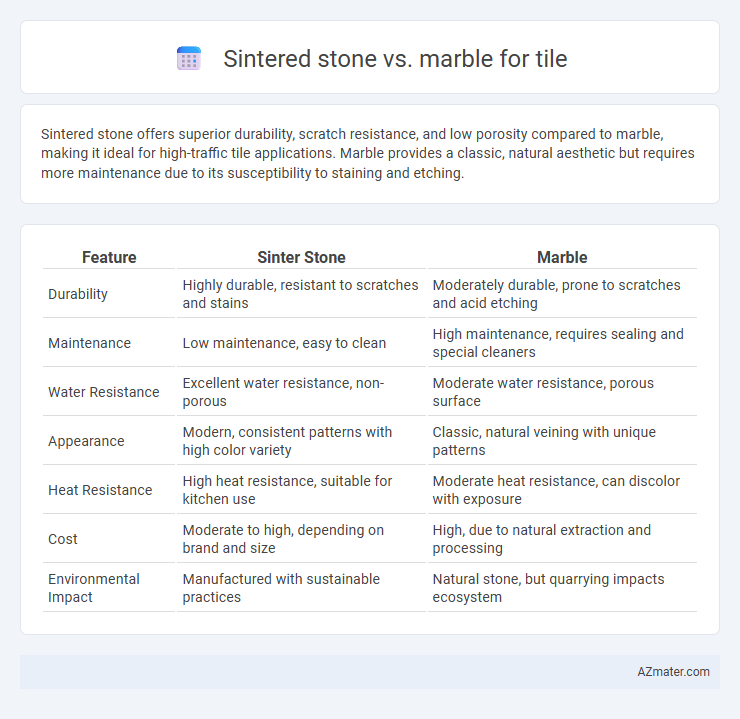Sintered stone offers superior durability, scratch resistance, and low porosity compared to marble, making it ideal for high-traffic tile applications. Marble provides a classic, natural aesthetic but requires more maintenance due to its susceptibility to staining and etching.
Table of Comparison
| Feature | Sinter Stone | Marble |
|---|---|---|
| Durability | Highly durable, resistant to scratches and stains | Moderately durable, prone to scratches and acid etching |
| Maintenance | Low maintenance, easy to clean | High maintenance, requires sealing and special cleaners |
| Water Resistance | Excellent water resistance, non-porous | Moderate water resistance, porous surface |
| Appearance | Modern, consistent patterns with high color variety | Classic, natural veining with unique patterns |
| Heat Resistance | High heat resistance, suitable for kitchen use | Moderate heat resistance, can discolor with exposure |
| Cost | Moderate to high, depending on brand and size | High, due to natural extraction and processing |
| Environmental Impact | Manufactured with sustainable practices | Natural stone, but quarrying impacts ecosystem |
Introduction to Sinter Stone and Marble Tiles
Sinter stone tiles are engineered using high-temperature and high-pressure processes that fuse natural minerals into a dense, non-porous surface renowned for durability and scratch resistance. Marble tiles, derived from metamorphosed limestone, offer unique veining and luxurious aesthetics but require regular sealing due to their porous nature. Both materials serve as premium options for flooring and wall applications, with sinter stone excelling in longevity and marble favored for its classic elegance.
Composition and Manufacturing Process
Sinter stone tiles are manufactured through a high-pressure sintering process that fuses natural minerals at ultra-high temperatures without using resin or additives, resulting in a dense, durable surface with superior hardness and resistance to scratches. Marble tiles consist primarily of calcite minerals formed through metamorphic processes, then cut and polished from natural stone blocks, offering unique veining but increased porosity and susceptibility to acids. The sintering process ensures sinter stone tiles have a more stable, non-porous composition compared to marble's crystalline, porous structure.
Appearance and Design Versatility
Sintered stone offers a consistent matte finish with earthy tones and subtle veining, providing a modern and sleek appearance ideal for minimalist designs. Marble features natural veining patterns and a polished surface, offering a timeless, luxurious look prized for classical and ornate interiors. The sintered stone's uniformity allows for greater design versatility with large-format tiles and seamless installations, whereas marble's unique patterns make each tile distinctive but may require more careful layout planning.
Durability and Strength Comparison
Sinter stone offers superior durability and strength compared to marble, making it highly resistant to scratches, stains, and impact damage. Its dense, non-porous structure prevents water absorption, reducing the risk of cracking and wear over time. Marble, while aesthetically elegant, is softer and more prone to chipping and etching, requiring more maintenance to preserve its surface integrity in high-traffic or heavy-use areas.
Resistance to Stains, Scratches, and Chemicals
Sintered stone offers superior resistance to stains, scratches, and chemicals compared to marble, making it ideal for high-traffic or heavy-use areas. Its non-porous surface prevents absorption of liquids and resists acidic substances that typically damage marble. Marble, while elegant, is softer and more porous, requiring regular sealing to protect against etching, staining, and surface damage from chemicals.
Maintenance and Cleaning Requirements
Sinter stone tiles require minimal maintenance due to their high resistance to stains, scratches, and water, making cleaning effortless with just mild soap and water. Marble tiles, while elegant, demand frequent sealing and gentle, pH-neutral cleaners to prevent etching and staining from acidic substances. Regular upkeep of marble includes prompt spill management and periodic resealing to maintain its polished appearance and durability.
Environmental Impact and Sustainability
Sinter stone tiles boast superior environmental benefits due to their manufacturing process, which consumes less water and emits fewer pollutants compared to marble quarrying, which often results in significant landscape disruption and waste generation. Sinter stone is made from natural raw materials compressed at high pressures without the need for extensive chemical treatments, enhancing its sustainability credentials. Marble tiles, while durable and recyclable, have a higher carbon footprint due to energy-intensive extraction and transportation, making sinter stone a more eco-friendly choice for sustainable building projects.
Cost Analysis: Sinter Stone vs Marble
Sinter stone offers a more cost-effective option compared to marble, with prices typically ranging from $30 to $60 per square foot, whereas marble can cost between $50 and $150 per square foot due to its natural origin and labor-intensive extraction process. Maintenance expenses also differ significantly; sinter stone requires minimal upkeep and resists stains and scratches better, reducing long-term costs, while marble demands regular sealing and careful cleaning to prevent discoloration and damage. Considering these factors, sinter stone provides a budget-friendly alternative with durable performance, whereas marble involves higher initial investment and ongoing maintenance expenses.
Installation Process and Considerations
Sinter stone tiles require professional installation due to their hardness and density, often needing specialized cutting tools and adhesives to prevent cracking. Marble tiles, being softer and more porous, allow for easier cutting and installation but demand careful sealing and moisture protection to avoid staining and damage. Both materials necessitate a level, clean substrate, but sinter stone's durability suits high-traffic areas, while marble's sensitivity calls for more delicate handling during installation.
Best Applications: Where to Use Each Material
Sintered stone is highly durable, stain-resistant, and ideal for heavy-traffic areas such as kitchen countertops, outdoor patios, and commercial flooring. Marble offers an elegant, natural look suited for low-traffic spaces like bathrooms, decorative wall cladding, and fireplace surrounds where its susceptibility to scratching and etching is less problematic. Choosing sinter stone for high-impact, moisture-prone environments ensures longevity, while marble enhances aesthetic appeal in controlled, interior settings.

Infographic: Sinter stone vs Marble for Tile
 azmater.com
azmater.com